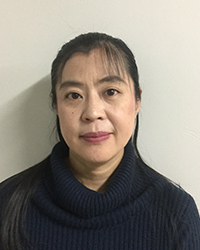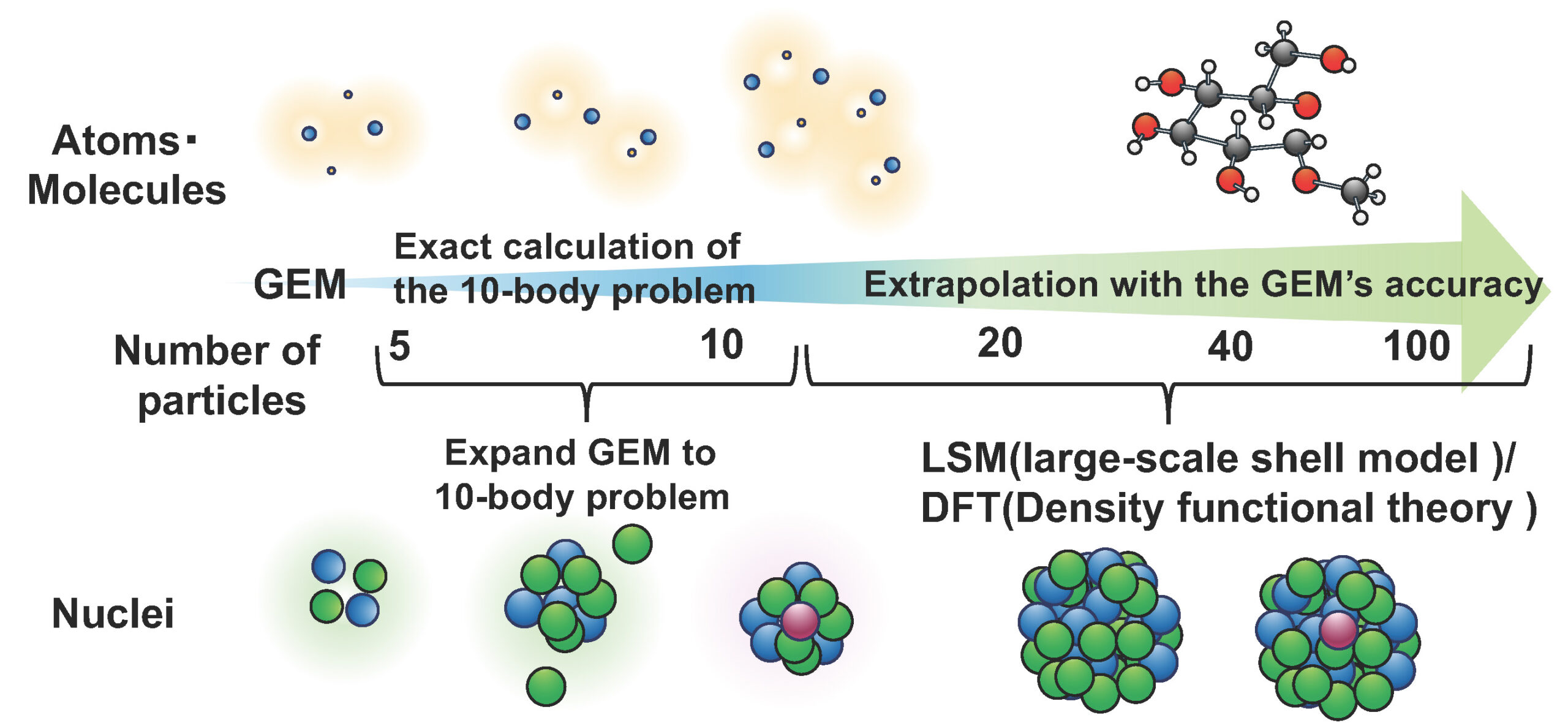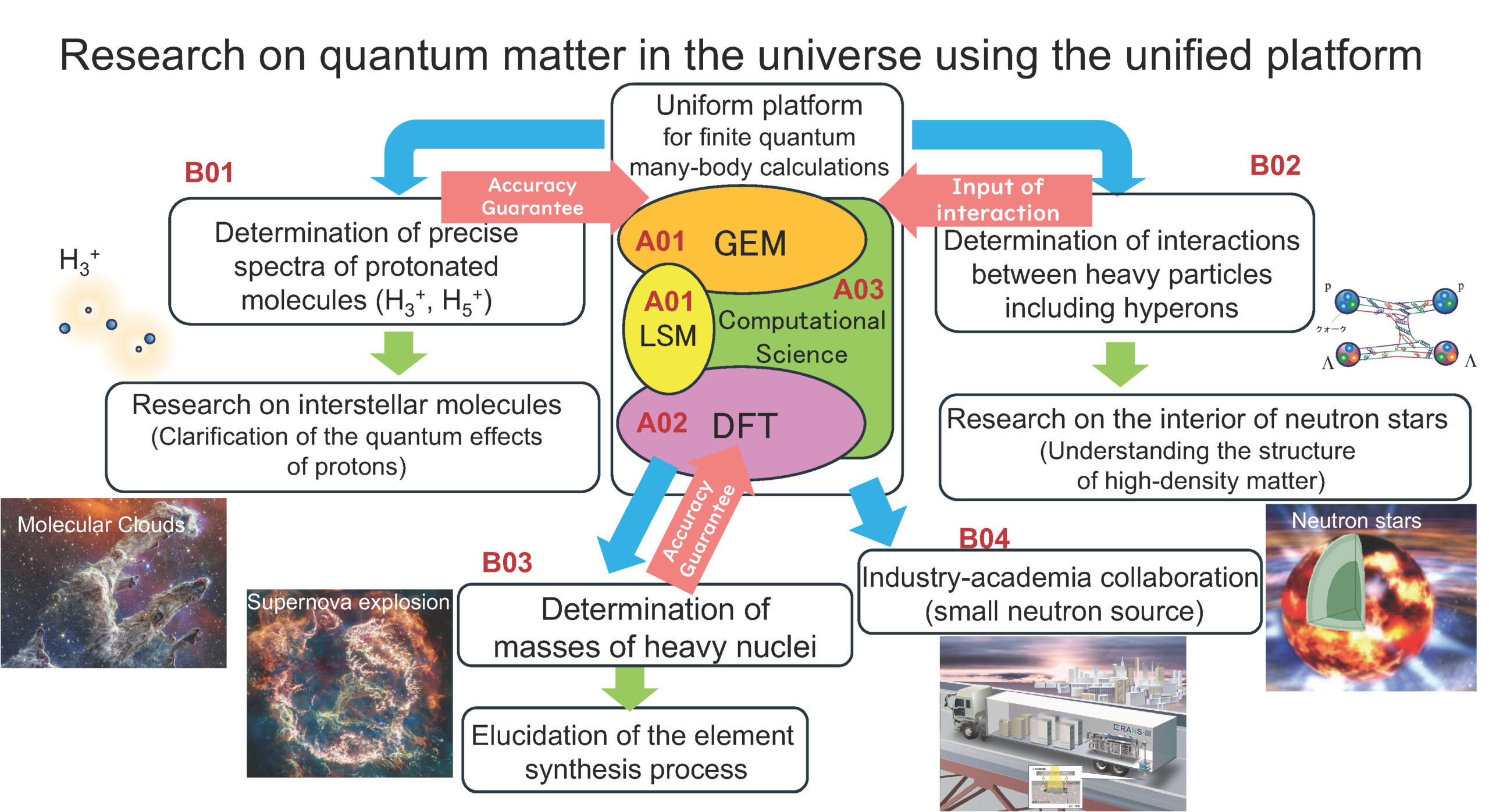Introduction of this research area
Principle Investigator
Emiko Hiyama
(Department of Physics, Tohoku University/group director, RIKEN)

In this Transformative Research Areas, we aim to build a theoretical calculation platform that can provide precise solutions for quantum many-body systems containing impurities ranging from 3 to 100 particles, and to bring about innovation in elucidating the formation and evolution of quantum matter in the universe by collaborating with precision experiments at each hierarchy of hadrons, atomic nuclei, and atoms and molecules. In the universe, as shown in Figure 1, protons and neutrons were created from the elementary particles quarks created in the Big Bang, and these gathered together to form atomic nuclei, and then evolved into atoms and molecules with electrons, spreading throughout space. This interstellar gas gathered together by gravity to form stars, and then massive stars exploded as supernovae, eventually leading to neutron stars, which can be said to be atomic nuclei bound by gravity. There are various problems to be solved in the process of material evolution in the universe. These include how molecules were formed in space, how heavy elements such as uranium were created, and what particles form the interior of neutron stars, the final form of material evolution.

These problems will be solved in one fell swoop if we can solve with high accuracy the fundamental equations (Schrödinger equations) for up to 100 finite quantum many-body systems interacting by electromagnetic and nuclear forces. The accuracy of calculations to solve the fundamental equations drops drastically for five or more body systems. Therefore, until now, model calculations have been performed using parameters that reproduce experiments. However, the reliability of the models is low, and they have no predictive power for subjects with little experimental data. It has also been difficult to correctly interpret the high-precision experimental data provided by Japan’s world-renowned experimental facilities, such as J-PARC and RIBF. In recent years, computational science has made great progress due to the appearance and operation of the world’s fastest supercomputer “Fugaku,” the evolution of computational algorithms, and the emergence of quantum annealing, which can significantly reduce computational costs. By collaborating with computational science experts, precise calculation of quantum many-body systems is becoming a reality. Taking advantage of this opportunity, this research area aims to establish a groundbreaking, highly accurate calculation method for finite quantum many-body systems that can be applied across a wide range of hierarchical levels, from atoms and molecules to atomic nuclei and hadrons, and to qualitatively transform research on the formation and evolution of quantum matter in the universe. Specifically, as shown in Figure 2, we will build a unified calculation platform for highly accurate handling of quantum many-body systems with 3 to 100 particles by integrating and unifying the infinitesimal displacement Gaussian expansion method (GEM), which is an exact calculation method that can be applied to systems with up to about 10 particles, with the large-scale shell model (LSM) and density functional theory (DFT), which are used for systems with tens to hundreds of particles. By combining this unified platform with experimental research at each level, we will attempt to elucidate the internal structure of neutron stars, the evolution of interstellar molecules, and the synthesis of heavy elements. We also hope that this will lead to the resolution of problems that have been a barrier not only in the fields of atomic nuclei and quantum chemistry, but also in many fields dealing with quantum matter in the universe.


An overview of this area is shown in Figure 3. At the center of the area is the theory groups (A01, 02, 03), which aims to build a unified platform for finite quantum many-body system calculations.
| A01 | Challenge to the exact calculation of quantum systems with more than 10 bodies(PI : Emiko Hiyama) |
| A02 | Refinement of Density Functional Theory for Exploring the Origin of Elements and the Properties of High-Density Nuclear Matter (PI : Kenichi Yoshida) |
| A03 | Construction of a unified platform for finite quantum many-body system calculations(PI :Issaku Kanamori) |
By locating and cooperating with experimental groups (B01, 02, 03, 04) in research areas where the finite quantum many-body system calculation platform constructed by the theory group can be fully utilized, we will attempt to elucidate the evolution and formation of quantum matter in the universe. The experimental group will also be responsible for ensuring the accuracy of the platform and providing interactions that serve as input for the platform.
| B01 | Nuclear quantum effects revealed by full-degree-of-freedom quantum chemistry and optical comb precision molecular spectroscopy(PI : Kana Iwakuni) |
| B02 | Elucidation of the forces between baryons through the collaboration of scattering experiments and lattice QCD, and its application to the study of hypernuclei(PI : Koji Miwa) |
| B03 | Research on heavy neutron-rich nuclei to clarify the synthesis process of heavy elements(PI : Shunji Nishimura) |
| B04 | Improvement of a small neutron source using precise numerical calculations(PI : Shinsuke Kawasaki) |
The B01 group will determine the precise spectrum of protonated molecules and ensure the accuracy of the GEM calculations by comparing them with the A01 GEM calculations. They will then conduct research on interstellar molecules, which is one way of elucidating quantum matter in the universe. The B02 group will determine the interactions between baryons, including hyperons, and use these interactions as inputs to calculate the structure of hypernuclei in a wide mass range using GEM and DFT, and compare them with experiments to investigate the many-body forces related to Λ hyperons. They will also attempt to elucidate the high-density matter structure inside neutron stars by determining the equation of state of neutron stars. The B03 group will compare the experimental and theoretical values of the mass and half-life of heavy neutron-rich nuclei to verify the accuracy of DFT. In cooperation with the A02 group, they aim to build a DFT that can predict the mass of atomic nuclei in a range that cannot be measured experimentally. Furthermore, as an example of the contribution of the computational platform to society, the B04 group will apply it to the development of a small neutron source, which is part of industry-academia collaboration.
The precise calculation method for quantum many-body systems is highly versatile and is expected to be used by researchers in a wide range of fields, not limited to the themes presented here. By developing and releasing a general-purpose program, we hope that it will be used in a variety of fields. Furthermore, we hope that this area of research will greatly advance the world of quantum matter in the universe.
